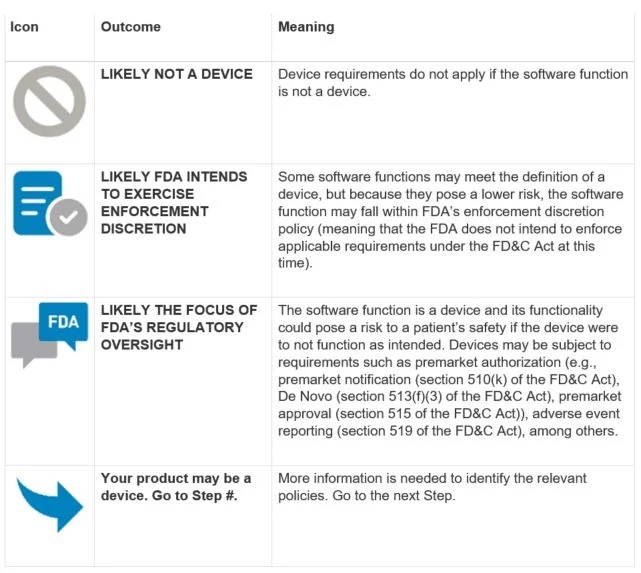- within Food, Drugs, Healthcare and Life Sciences topic(s)
- with Senior Company Executives, HR and Finance and Tax Executives
- with readers working within the Consumer Industries and Healthcare industries
The convergence of wearable technology and artificial intelligence systems that can analyze data in real time to optimize health care delivery is generating a new wave of products that raise novel regulatory, business, and intellectual property considerations. If you are developing a digital health or software product, it may contain software functions that are considered "devices" as that term is defined in section 201(h) of the Federal Food, Drug, and Cosmetic (FD&C) Act and are subject to US. Food and Drug Administration (FDA) oversight as devices.
The Digital Health Policy Navigator Tool
To assist in this evaluation process, the FDA has developed a useful tool, the Digital Health Policy Navigator, that can help guide companies through the evaluation process to determine whether new products or services they may be offering in the digital health space are subject to FDA regulations for devices. While this navigation tool should not be used in place of FDA counsel to make a determination of whether a product or service is covered, it can be helpful for companies that are evaluating new offerings to help illuminate which portions of FDA regulations are likely to be applicable (or whether none are applicable). The preliminary feedback provided by this navigation tool can then be further reviewed together with FDA counsel.
The navigation tool includes seven questions:
- Step 1: Is the software function intended for a medical purpose?
- Step 2: Is the software function intended for administrative support of a health care facility?
- Step 3: Is the software function intended for maintaining or encouraging a healthy lifestyle?
- Step 4: Is the software function intended to serve as electronic patient records?
- Step 5: Is the software function intended for transferring, storing, converting formats, or displaying data and results?
- Step 6: Is the software function intended to provide clinical decision support?
- Step 7: Does the Device Software Functions and Mobile Medical Applications Guidance apply?
Based on the answers to these seven questions, the navigation tool will then display one of the following outcomes:

Impact
While the navigation tool has its limitations, it identifies and raises key questions stemming from a number of digital health guidances, including: General Wellness: Policy for Low Risk Devices; Medical Device Data Systems, Medical Image Storage Devices, and Medical Image Communications Devices; Clinical Decision Support Software; and the Policy for Device Software Functions and Mobile Medical Applications. The tool shows that the FDA is also trying to "innovate" in the area and provide new resources for companies navigating this space.
Understanding the regulatory pathway can also provide opportunities for coordinating patent exclusivity and regulatory exclusivity. For example, some digital health products may be eligible to receive data exclusivity from the FDA, and if they are paired with a traditional therapeutic, then certain kinds of patents may also be listable in the FDA's Orange Book. An integrated approach with combined input from regulatory and IP counsel can be helpful to leverage all available types of protection.
The content of this article is intended to provide a general guide to the subject matter. Specialist advice should be sought about your specific circumstances.



